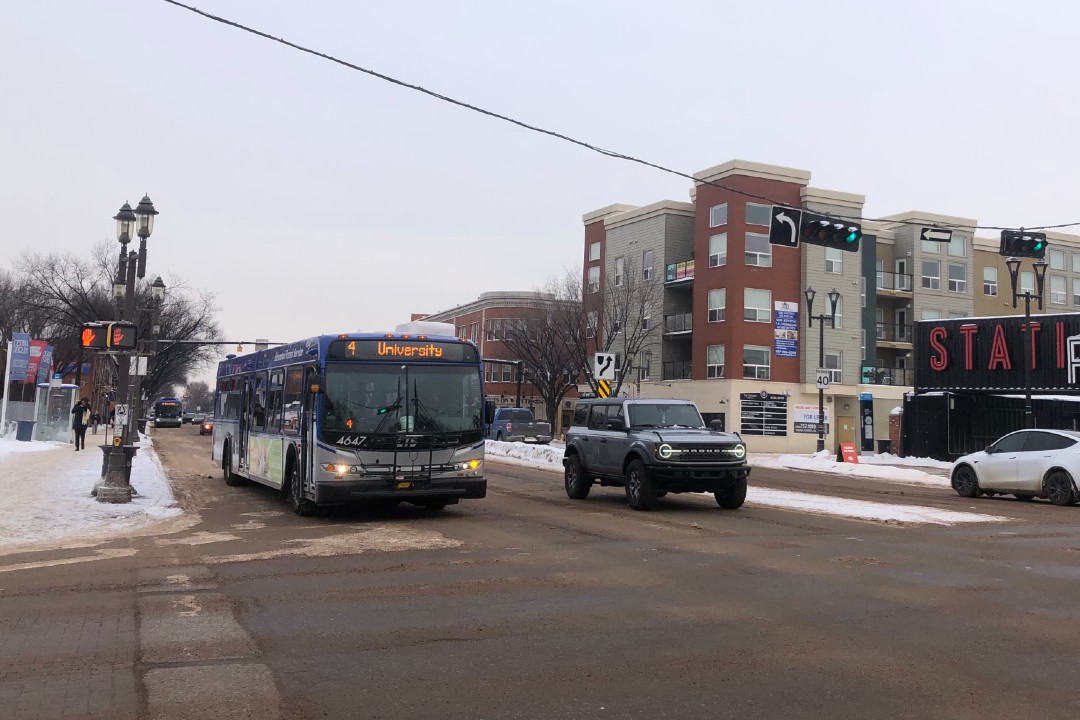The city is set to install a dedicated bus lane along parts of 101 Street downtown, one of eight streets that will see changes to give buses priority over other vehicles.
The bus lane is part of a suite of changes set to be installed across the city in 2025 and 2026 that are meant to improve operational efficiency and reduce travel times along major bus routes using a relatively small budget, a city report said. Council approved $7.1 million for the planning, design, and implementation of the transit priority measures in the 2023-2026 budget.
The city has planned changes along the following streets:
- Jasper Avenue (95 Street to 109 Street)
- 101 Street (Kingsway to Jasper Avenue)
- 97 Avenue (105 Street to 109 Street)
- 97 Street (107 Avenue to 118 Avenue)
- Hewes Way (23 Avenue to 28 Avenue)
- 118 Avenue at 80 Street
- Whyte Avenue (99 Street to 109 Street)
The city will adjust traffic signal phasing on each route so that buses can move through intersections more efficiently, a city spokesperson told Taproot. Other changes include queue jumps on 97 Avenue and Jasper Avenue, which will allow a bus to proceed before other traffic when a traffic light turns green; parking restrictions on 97 Street; and intersection modifications on Whyte Avenue, Jasper Avenue, and 97 Street. The city will extend sidewalks to make boarding and disembarking buses easier and to reduce pedestrian crossing distances at intersections. The entire list of changes is laid out in a council memo.
Daniel Witte, board chair of Edmonton Transit Riders, told Taproot that as Edmonton's population grows, it's important to improve the transit experience to encourage ridership.
"We don't want the 40 people in one bus to be stuck behind three or four cars, meaning they can't get through an intersection," Witte said. "This is about identifying spot locations that are in most need of congestion (relief) as our population grows, and addressing those with very effective and targeted remedies that make the transportation experience better for everyone."
Witte said that the city could have been more ambitious. "The fact that with the majority of these measures we're only seeing signal timing changes is a bit disappointing," Witte said. "I think that we, ideally, (would have) a lot more transit lanes and bus lanes implemented in the city in the places that we need them. Even things like queue jumps and transit priority signalling are so, so good and effective. It would be really great to see some more of those implemented."
City administration is currently planning bus rapid transit routes that will have dedicated bus lanes for at least 75% of the route. Two of the routes include parts of Whyte Avenue. The Old Strathcona Public Realm Strategy also calls for dedicated transit lanes on Whyte Avenue. As part of the transit priorities project, there will not be dedicated bus lanes installed on Whyte Avenue, the city said.
Witte said he had hoped the transit priority measures and the bus rapid transit routes on Whyte Avenue could be paired together. "If we can get those done simultaneously so we don't have to redo work and switch up the road five or six times — if we can only do it once or twice, I think everyone would prefer that."

